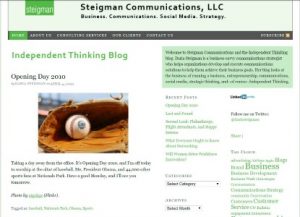You might have noticed that I launched a revamped website.
Call it web design Version 4.0.
Version 1.0 was a corporate brochure. Awkward template and basic information. The blog section, which I added in once blogging software became easier to use, looked tagged on. (Don’t judge me.) Version 2.0 embraced WordPress. It was appropriately branded, but the approach was all wrong. (Well, all wrong once you thought about it.) Here’s a picture of Version 2.0 from 2010, courtesy of the Wayback Machine.

The problem is that it made me look like a blogger with a business rather than a business owner with a blog.
Version 3.0 was brand consistent, mobile friendly, prioritized my business, and did its job very well.
This is where too many businesses get stuck. I get it, your site looks pretty, or customers can do what you need them to do, so why mess with it? But there’s more to an effective website than just its look, or just its navigation, or just its bells and whistles. So let’s look at why every business should put web design on the agenda at regular intervals.
Web design changes.

Think of this as your fashion moment. If you’re wearing bell bottoms, the 70s want their jeans back. If you’re wearing shoulder pads (and you’re not a football player), the 80s want their jackets back. If your website looks stale, you have a problem.
Web design changes. Sites being designed today don’t look the same as sites from 2010 or even 2014. It’s okay to be retro, but not out of date.
Sibley Hospital (near me) just built a new, state-of-the-art building. By all accounts, it’s beautiful. But everything about Sibley’s website screams stodgy, formulaic, and old-fashioned. Contrast that to Children’s National. I can find you examples from restaurants, law firms, trade associations, and pretty much any category of business.
Here’s the point: your business doesn’t stand still, so how can you let such a significant representation of your business stagnate?
Google doesn’t stand still.
Google isn’t just about content and SEO. It’s also, more and more, looking at speed and security. Is your website mobile responsive? How fast does your site load? Do you have https protocols in place? Are you using AMP?
Let’s be clear: I can look at basic HTML coding, and I know what a fast (or slow) website looks like. But I’m not a tech specialist, and you don’t need to be either. But all these factors are impacting how the pages on your website rank in Google search. Sometimes you can deploy a plug-in to get around a problem, but for how long?
My last website was based on a custom WordPress theme. I loved that I could customize sidebars, for example. The problem was that because it was customized it wasn’t updating as change happened. My new theme is based on Divi. While I can’t customize quite as much, Elegant Themes provides regular Divi updates. Now I know that when Google’s suddenly looking for a specific piece of code, Divi’s got me covered.
Your business doesn’t stand still.
Here’s why redoing a website is so hard: you have to think. More to the point, you have to rethink your navigation (or site architecture), the pages you have (or are missing), the messaging, and how it all fits together. This isn’t an easy exercise.
For example, my new home page has a “Learn More” button on the home screen. Looking at the first iteration of my new site, my brother asked, “What’s the most important information you want prospects to know?”
In other words, if I can only get you to click once, where do I want to direct you? Good web design needs to answer dozens of questions like this. Asking them at regular intervals forces your organization to confront its strengths and weaknesses and figure out what your priorities are and should be.
Invest in your future.
Website redesign is an investment in your business. Isn’t that reason enough to revisit yours?
Railway booths by Gemma Evans (Unsplash).



